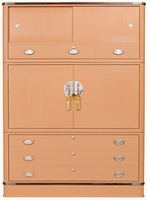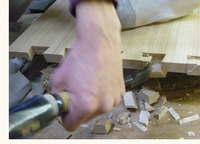

Total:131items
- Pottery & Porcelain (18)
- Lacquerware (4)
- Glasswork (2)
- Wood & Bamboo Work (19)
- Hakone Yosegi Zaiku: Hakone Marquetry
- Boshu Uchiwa: Boshu Fans
- Nikko-bori: Nikko carving
- Sasebo Koma (Sasebo Spinning Top)
- Shimoda Yanimatsu Zaiku (Shimoda Joinery of Oily Pine)
- Echizen Takeningyo (Bamboo Dolls)
- Osaka Senshu Kiri-dansu: Paulownia chest of drawers or wardrobes of Senshu, Osaka
- Kitayama Maruta: Japanese cedar logs
- Yodoegasa: Yodoe umbrella
- Atami Kusu Zaiku: Atami Camphor wood crafts
- Kawatsura Kokeshi Doll
- Itaya Zaiku: Itaya Bark Craft
- Yokohama Classic Furniture
- Hinaga Uchiwa: Hinaga Fan
- Torafu Takezaiku: Tiger Bamboo Work
- Tsuruzaiku: Woven Vine Craft
- Okawa Kumiko: Okawa Kumiko Wood Joinery
- Shuro Houki: Hemp-palm Broom
- Furyumen: Wood Carving Mask
- Leather Work (1)
- Papermaking (13)
- Textile (20)
- Dyeing products (5)
- Masonry (1)
- Metal Work (11)
- Stationery (4)
- Livingware (3)
- Accessory (4)
- Toys & Entertainment (14)
- Interior (2)
- Other crafts (10)

 |
Main Production Site:Osaka |
 《Characteristics》
《Characteristics》"Osaka Senshu Kiri-dansu (paulownia wardrobe made in Senshu, Osaka)" is called "the highest quality of all paulownia wardrobes in Japan". Many "dou maru-gata (a type of wardrobe with rounded off corners) of Osaka Senshu Kiri-dansu are created with careful work which can be seen in their numerous wooden joints. The excellent work of the furniture exudes a stately atmosphere.
"Osaka Senshu Kiri-dansu" also has following features.
[Moisture-proof property]
When paulownia wood contains moisture, its surface expands and becomes clogged which helps the surface shut out extra moisture from outside. In contrary, dry air makes air pockets in the wood to keep stable humidity inside the wood. Therefore, humidity inside a paulownia product always stays constant.
[Flame-retardant property]
When water falls on paulownia wood, water quickly permeates through the wood to make the state of flame-retardant which protects things inside of the wardrobe from fire, even though its outside is burnt down. This is why paulownia wood is used for inner boxes of safes and cases for fine arts and crafts.
[Antifouling property]
The specialty of the chest (product) made of completely dried paulownia wood is its unique surface finishing. Firstly, the surface is rubbed with "Uzukuri", a tool made with Japanese silver grass roots, and then sandpapered to show the wood grain.
Secondly, the surface of the chest is painted with mixed colorant made from roasted Yasha (Alnus firma) nuts and polishing powder. After being dried, the surface is rubbed and filed with "Uzukuri" again.
Finally, it is coated with wax for waterproofing and wiped with a dry cloth. The traditional way of finishing work gives antifouling property to the product.
This is to say "Osaka Senshu Kiri-dansu" is the best storage furniture suitable to Japanese climate. And it is also called "the greatest of all paulownia chest of drawers (wardrobe)."
[National Designated Traditional Craft (designated by minister of Economy and Industry)]
Source: Osaka Senshu Kiri-dansu Manufacturing Cooperative Association
Translation: Marie Mine, reviewed by Naoko Yamashita

| Materials | Paulownia wood
|
|---|---|
| Crafting Processes | 【1】 Selecting paulownia logs
Selecting paulownia logs is the most important process for the best paulownia product. 【2】Lumbering The logs are dried over a fire and air dried for one or two years. After that, logs are checked to decide how to utilize their annual rings and shapes to show the wood grain. Then logs are lumbered after the proper length and thickness are decided as well as the wood grain pattern (plain or cross) on the products. 【3】Natural drying Natural drying is the best drying method before processing paulownia wood. By natural drying, scum contained in the wood is removed and the wood contracts to the best condition for manufacturing. One to three years of natural drying according to the thickness of lumbers is done to prevent the paulownia wood from deformation and discoloration after products are completed. 【4】Joining the lumbers This is the most important process that decides the price of a paulownia chest. The material wood is selected according to the type or the rank of the chest which is going to be made. Pieces of wood with similar grain patterns, straight or irregular grain, are joined together to make each part of a chest. What is important in this process is to show a perfect wood grain on the joined board. 【5】Front plate installation This process is to attach front plates to the body ,which form the face of a wardrobe. Approximately 40 to 50-year-old valuable lumber is used for front plates of hinged doors and drawers of a wardrobe, of which wood grain is arranged parallel to each other. But sometimes, irregular woodgrain is used as a design. 【6】Correcting warpage Warpage occurred on the board during natural drying is corrected by hot pressing or heating. 【7】Joining wood members to make wardrobe parts Selected wood members are connected together to make enough size of each parts. 【8】Making wooden basis The boards are cut off into required size for a top board, a shell plate, drawers and doors after being planed to make smooth surface . 【9】Making joints Before assembling the parts of the body, wooden joints such as tenons and mortises are made on them. 【10】 Body assembly After being processed individually, all parts are assembled to make a body of a wardrobe. A joining method called dovetail joint is applied and wooden pegs are used to improve strength on the joints. It is an important process for a sturdy product. 【11】 Drawers and bottom plates A bottom plate is joined to side plates of a drawer with wooden pegs after all the side plates are connected together with lap dovetail joint. The drawers are set into the a chest of the wardrobe with least space for withdrawing. High technique by 0.01mm level is required when planing the surface of all parts 【12】Hinged doors and sliding doors Hinged doors and sliding doors are precisely set to the main body so as not to make any gap when the doors are closed. With this process, the main body of the wardrobe is completed. 【13】Brushing woodgrain with Uzukuri With a tool called Uzukuri which is made with roots of Japanese silver grass (susuki), wood grain of paulownia is brushed to make a good appearance of the woodgrain. 【14】Coloring (finishing work with polishing powder) A polisher made of whetstone powder and extraction of Alnus firma (Betulaceae) nut is lacquered with brush along the wood grain on the chest. After several times of brushing, the surface is evenly covered with wax made from ligustrum obtusifolium to be burnished. Recently, there are various ways of surface finishing, such as "Yaki-kiri shiage" (burning surface of the wood to make clear woodgrain) and oil finishing. 【15】Attaching metal fittings Metal fittings on (front side, handgrips, locks, hinges and clasps for a pole) are carefully attached on the wardrobe. 【16】Checking This is the last process to check defects and flaws on the wardrobe. Once the wardrobe passes the inspection, a certification of traditional craft is issued and labeled on it. |
| History | It is said that Japanese people started to use wardrobes in Edo period (17-19c), Osaka was the place where wardrobes were first produced and widely used.
Osaka is located in the center of Japan, which was the best distribution base. The benefit of the location made the city rich where all necessaries of life were gathered. Rich people in Osaka started to own extra kimono and miscellaneous goods. As a storage space, they started to use wardrobes to keep them. This is why wardrobes became common in Osaka. According to the increasing demand of wardrobes, and the good balance between supply and demand helped the development of storage furniture manufacturing in Osaka. At the end of Edo period (17-19c), agricultural technique improvement and mild climate brought enough harvest to accumulate a fortune to farmers in Kinki area. Farmers distributed their property to their children by means of marriage furniture when their daughters get married. Marriage furniture was not only parents' compassion to give their daughters better treatment in the family they married into. It was also a proof of their financial ability. With these backgrounds, craftsmen of Osaka Senshu Kiri-dansu have improved their skills by meeting high demands from consumers for furniture with high quality, delicate work and beautiful appearance, which made Kiri-dansu more than a useful and sturdy furniture. |
◆Exhibition / Showcase
Hatsune Furniture (Hatsune no Kagu)
2-18-5 Araki-cho, Kishiwada, Osaka 596-0004
TEL +81-(0)72-443-8835 FAX +81-(0)72-443-8837
(Japanese only)
Hatsune Furniture Craft Center
1-19-8 Yoshii-cho, Kishiwada, Osaka 596-0002
TEL +81-(0)72-443-5691 FAX +81-(0)72-443-5692
(Japanese only)
Assistance needed? For inquiries in English:
JTCO Contact Form
Your inquiries will be forwarded by JTCO in Japanese to the organization you wish to contact.



